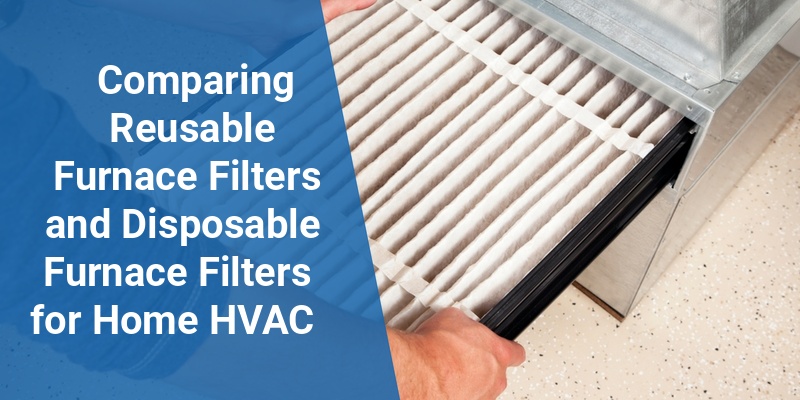Choosing between a reusable furnace filter and a disposable one is a common decision for homeowners seeking to maintain indoor air quality and HVAC efficiency. Each type has distinct advantages and considerations related to cost, environmental impact, filtration performance, and maintenance. This article provides an in-depth comparison of reusable and disposable furnace filters to help homeowners select the best option for their needs.
| Feature | Reusable Furnace Filter | Disposable Furnace Filter |
|---|---|---|
| Cost Over Time | Higher upfront cost, lower ongoing cost | Lower initial cost, recurring replacement costs |
| Filtration Quality | Varies; often moderate to high | Wide range from basic to high-efficiency |
| Maintenance | Requires regular washing and drying | Replace and dispose when dirty |
| Environmental Impact | Less waste, reusable materials | Creates landfill waste due to disposal |
| Convenience | More effort for upkeep | Easy and quick replacement |
How Furnace Filters Work to Improve Air Quality
Furnace filters are essential components of home HVAC systems designed to trap dust, pollen, pet dander, and other airborne particles. By capturing contaminants, filters help maintain clean air within living spaces and protect heating and cooling equipment from debris-related damage.
The effectiveness of a furnace filter depends on its material, design, and MERV rating (Minimum Efficiency Reporting Value), which measures the ability to capture particles of varying sizes. Both reusable and disposable filters serve this filtration purpose but utilize different materials and maintenance approaches.
Characteristics of Reusable Furnace Filters
Reusable furnace filters are made from durable materials such as washable foam or electrostatic mesh designed to withstand multiple cleaning cycles. Homeowners can remove, wash with water or mild soap, dry, and reinstall these filters, making them a sustainable choice over time.
Key features include:
- Durability: Built to last several years with proper maintenance.
- Initial Cost: Generally higher than disposable filters but offset by no replacement purchases.
- Cleaning Frequency: Requires regular cleaning every 1 to 3 months depending on usage and air quality.
- Performance: Offers moderate filtration; some models have electrostatic properties to attract particles.
Characteristics of Disposable Furnace Filters
Disposable furnace filters are commonly made from pleated paper or fiberglass media designed to be replaced after use. These filters are convenient for homeowners who prefer low-maintenance solutions.
Important considerations are:
Call 888-906-9139 for Free Local HVAC Quotes – No Obligation, Just Savings!
- Cost: Lower upfront cost but needs replacement every 1 to 3 months.
- Filtration Range: Available in various MERV ratings, including high-efficiency particulate air (HEPA) filters for superior filtration.
- Ease of Use: Simple to remove and replace without cleaning.
- Environmental Impact: Increased waste due to regular disposal.
Comparing Filtration Effectiveness
Both reusable and disposable filters can effectively trap common household particulates, but disposable filters typically provide a wider selection of filtration levels. High MERV-rated disposable filters can capture smaller particles like mold spores and smoke better than many reusable versions.
However, reusable filters with electrostatic designs can attract and hold dust and allergens efficiently but might not reach the very high filtration standards required for sensitive environments such as allergy sufferers’ homes.
Cost Analysis Over Time
Reusable filters involve a higher upfront investment, often costing two to three times more than a single disposable filter. However, because they last for years with proper care, the total cost of ownership is usually lower in the long run.
Disposable filters require frequent repurchasing, which accumulates costs over time. For example, replacing a $10 disposable filter every two months totals approximately $60 per year, while a reusable filter might cost $40-$60 once with minimal maintenance expenses.
Maintenance and Convenience Considerations
Reusable filters require consistent upkeep, including washing, drying, and reinstalling, which can be time-consuming. Failure to maintain the filter properly can reduce HVAC efficiency and air quality.
Disposable filters offer convenient, no-fuss replacement. Homeowners simply swap out the old filter for a new one, minimizing maintenance effort. This convenience translates well for those with busy lifestyles or less technical inclination.
Environmental Impact of Both Filter Types
Reusable filters produce significantly less waste by eliminating the need for frequent disposal. Washing and reuse reduce environmental burden by conserving materials and lowering landfill contributions.
Call 888-906-9139 for Free Local HVAC Quotes – No Obligation, Just Savings!
In contrast, disposable filters generate continuous waste that adds to landfill volume. Choosing filters with biodegradable media or recycling options can somewhat mitigate this impact but does not eliminate it.
Factors to Consider When Choosing Between Reusable and Disposable Filters
Several factors influence the best filter choice for a home HVAC system:
- Air Quality Needs: High filtration may require disposable HEPA filters.
- Budget: Consider upfront vs. long-term costs.
- Maintenance Willingness: Willingness to clean reusable filters regularly.
- Environmental Concerns: Preference for sustainability favors reusable filters.
- Equipment Compatibility: Check HVAC manufacturer recommendations for filter types.
Recommendations for Homeowners
Homeowners seeking to balance cost, filtration, and environmental responsibility can consider the following approaches:
- Use reusable filters in less dust-prone environments with regular cleaning schedules.
- Select mid-range MERV-rated disposable filters for enhanced air quality in allergy-sensitive homes.
- Combine both types by using reusable filters as pre-filters to catch larger particles and disposable high-efficiency filters for finer filtration.
- Follow HVAC system guidelines to avoid warranty issues and ensure optimal performance.
